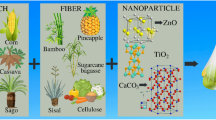Abstract
Green composites of polypropylene (PP) and corncob (CCB) agricultural residue with CCB content ranging from 5 to 30 wt% were compounded by melt extrusion and their properties investigated by density measurements, thermogravimetric analyses, differential scanning calorimetry, scanning electron microscopy (SEM) and tension, flexural and impact properties. Properties were dependent on CCB content. SEM micrographs showed that PP/CCB composites are composed of all layers of the corncob, but with a higher content of woody ring and pith. Composites with CCB up to 20 wt% presented particles evenly dispersed into PP matrix and density values ranging from 0.929 to 1.026 g/cm3. Thermal analyses showed that CCB is thermally stable up to 200 °C, ensuring that no degradation took place during processing, and PP/CCB composites are more crystalline than neat PP. Tensile strength and elongation at break of the composites decreased respectively from 30 to 20 MPa, and 22.7 to 3.7%, and the elastic modulus increased while the impact strength remained practically constant at 14 J/m for the filling contents tested. Elastic and flexural moduli increased respectively from 906 MPa to 1.1 GPa and from to 1.26 to 1.81 GPa with corncob addition.







Similar content being viewed by others
References
Satyanarayana KG, Arizaga GGC, Wypych F (2009) Biodegradable composites based on lignocellulosic fibers—an overview. Prog Polym Sci 34:982–1021. https://doi.org/10.1016/j.progpolymsci.2008.12.002
Mohanty AK, Misra M, Hinrichsen G (2000) Biofibres, biodegradable polymers and biocomposites: an overview. Macromol Mater Eng 276–277:1–24. https://doi.org/10.1002/(SICI)1439-2054(20000301)276:1%3c1:AID-MAME1%3e3.0.CO;2-W
Van De Velde K, Kiekens P (2002) Biopolymers: overview of several properties and consequences on their applications. Polym Test 21:433–442. https://doi.org/10.1016/S0142-9418(01)00107-6
Medeiros ES, Santos ASF, Dufresne A, et al (2013) Bionanocomposites. In: Polymer composites. Wiley, pp 361–430
Faruk O, Bledzki AK, Fink H-P, Sain M (2014) Progress report on natural fiber reinforced composites. Macromol Mater Eng 299:9–26. https://doi.org/10.1002/mame.201300008
Silvério HA, Flauzino Neto WP, Dantas NO, Pasquini D (2013) Extraction and characterization of cellulose nanocrystals from corncob for application as reinforcing agent in nanocomposites. Ind Crops Prod 44:427–436. https://doi.org/10.1016/j.indcrop.2012.10.014
Guan J, Hanna MA (2004) Functional properties of extruded foam composites of starch acetate and corn cob fiber. Ind Crops Prod 19:255–269. https://doi.org/10.1016/j.indcrop.2003.10.007
Panthapulakkal S, Sain M (2007) Agro-residue reinforced high-density polyethylene composites: fiber characterization and analysis of composite properties. Composite A 38:1445–1454. https://doi.org/10.1016/j.compositesa.2007.01.015
Donnelly BJ, Helm JL, Lee HA (1973) The carbohydrate composition of corn cob hemicelluloses. Cereal Chem 50:553–563
Monroe KP (1921) The preparation and technical uses of furfurai. J Ind Eng Chem 13:133–135. https://doi.org/10.1021/ie50134a012
Ferreira-Leitao V, Gottschalk LMF, Ferrara MA et al (2010) Biomass residues in Brazil: availability and potential uses. Waste and Biomass Valorization 1:65–76. https://doi.org/10.1007/s12649-010-9008-8
Crop Production 2015 Summary (January 2016). USDA, National Agricultural Statistics Service, United States Department of Agriculture. https://www.usda.gov/nass/PUBS/TODAYRPT/cropan16.pdf
Qawasmeh A, Obied HK, Raman A, Wheatley W (2012) Influence of fungal endophyte infection on phenolic content and antioxidant activity in grasses: interaction between Lolium perenne and different strains of Neotyphodium lolii. J Agric Food Chem 60(13):3381–3388. https://doi.org/10.1021/jf204105k
Trostle R (2008) Global agricultural supply and demand: factors contributing to the recent increase in food commodity prices. International Agriculture and Trade Outlook No. (WRS-0801), 30 p. https://www.ers.usda.gov/webdocs/publications/40463/12274_wrs0801_1_.pdf?v=0
Anulacion M (2019) Brazil corn: production estimated higher. United States Department of Agriculture, Foreign Agricultural Service, World Agricultural Production. Circular Series WAP 4–19 April 2019. https://apps.fas.usda.gov/psdonline/circulars/production.pdf
Lal R (2005) World crop residues production and implications of its use as a biofuel. Environ Int 31:575–584. https://doi.org/10.1016/j.envint.2004.09.005
Marques MF, Melo R, da Araujo RS et al (2014) Improvement of mechanical properties of natural fiber–polypropylene composites using successive alkaline treatments. J Appl Polym Sci Banner 3:150. https://doi.org/10.1002/app.41710
Pickering KL, Efendy MGA, Le TM (2016) A review of recent developments in natural fibre composites and their mechanical performance. Composites A 83:98–112. https://doi.org/10.1016/j.compositesa.2015.08.038
Ku H, Wang H, Pattarachaiyakoop N, Trada M (2011) A review on the tensile properties of natural fiber reinforced polymer composites. Composite B 42:856–873. https://doi.org/10.1016/j.compositesb.2011.01.010
Li X, Tabil LG, Panigrahi S (2007) Chemical treatments of natural fiber for use in natural fiber-reinforced composites: a review. J Polym Environ 15:25–33. https://doi.org/10.1007/s10924-006-0042-3
Rosa MF, Medeiros ES, Malmonge JA et al (2010) Cellulose nanowhiskers from coconut husk fibers: effect of preparation conditions on their thermal and morphological behavior. Carbohydr Polym 81:83–92. https://doi.org/10.1016/j.carbpol.2010.01.059
Satyanarayana KG, Arizaga GGC, Wypych F (2009) Progress in polymer science biodegradable composites based on lignocellulosic fibers—an overview. Prog Polym Sci 34:982–1021. https://doi.org/10.1016/j.progpolymsci.2008.12.002
Chen M, Xia L, Xue P (2007) Enzymatic hydrolysis of corncob and ethanol production from cellulosic hydrolysate. Int Biodeterior Biodegradation 59:85–89. https://doi.org/10.1016/j.ibiod.2006.07.011
Husseinsyah S, Marliza MZ, Selvi E (2014) Biocomposites from polypropylene and corn cob: effect maleic anhydride grafted polypropylene. Adv Mater Res Adv Mater Res 3:129–137
Ramiah MV (1970) Thermogravimetric and differential thermal analysis of cellulose, hemicellulose, and lignin. J Appl Polym Sci 14:1323–1337. https://doi.org/10.1002/app.1970.070140518
Jancar J, Tochacek J (2011) Effect of thermal history on the mechanical properties of three polypropylene impact-copolymers. Polym Degrad Stab 96:1546–1556. https://doi.org/10.1016/j.polymdegradstab.2011.05.013
Tocháček J, Jančář J, Kalfus J, Hermanová S (2011) Processing stability of polypropylene impact-copolymer during multiple extrusion—effect of polymerization technology. Polym Degrad Stab 96:491–498. https://doi.org/10.1016/j.polymdegradstab.2011.01.018
Peterlin A (1971) Chain scission and plastic deformation in the strained crystalline polymer. J Polym Sci Part C 32:297–317. https://doi.org/10.1002/polc.5070320116
Peterlin A (1971) Molecular model of drawing polyethylene and polypropylene. J Mater Sci 6:490–508. https://doi.org/10.1007/BF00550305
Chun KS, Husseinsyah S (2013) Polylactic acid/corn cob eco-composites: effect of new organic coupling agent. J Thermoplast Compos Mater. https://doi.org/10.1177/0892705712475008
Acknowledgements
The authors would like to thank the Brazilian Research Council (CNPq) and Coordination for the Improvement of Higher Education Level Personnel (CAPES) for the financial aid provided. Thanks are also due to Dr. L. H. Carvalho for helping with polymer processing.
Funding
This study was funded by National Research Council (CNPQ).
Author information
Authors and Affiliations
Corresponding author
Additional information
Publisher's Note
Springer Nature remains neutral with regard to jurisdictional claims in published maps and institutional affiliations.
Rights and permissions
About this article
Cite this article
Ramos, R.R.F., Siqueira, D.D., Wellen, R.M.R. et al. Development of Green Composites Based on Polypropylene and Corncob Agricultural Residue. J Polym Environ 27, 1677–1685 (2019). https://doi.org/10.1007/s10924-019-01462-7
Published:
Issue Date:
DOI: https://doi.org/10.1007/s10924-019-01462-7




